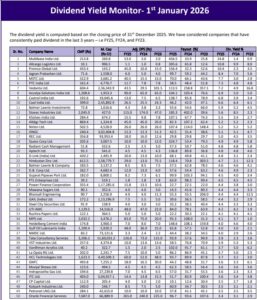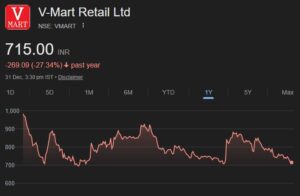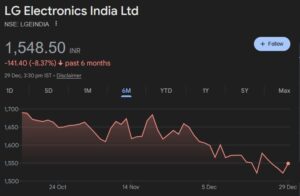
When you peep into Prof Sanjay Bakshi’s portfolio, your eyes will be dazzled to see winners like Relaxo Footwears, Thomas Cook, Poddar Developers, Ashiana Housing, Ambika Cotton, Kitex Garments, Symphony Coolers etc.
Each of these stocks is a super-duper multibagger. One of them (Relaxo Footwears) is a magnificent seven-bagger!
However, one stock stands out like a sore thumb. It has totally lost its way and is languishing. It has betrayed the confidence that the Prof reposed in it.
That stock is Vaibhav Global.
Over the past one year, the stock has lost a whopping 47%.
As wannabe-savvy investors, it is our bounden duty to investigate the reasons for Vaibhav Global’s poor shape. After our study, we have to conclude that either the Prof has got his stock pick wrong or that there is an once-in-a-lifetime opportunity to make mega bucks staring us in the face.
The first thing we have to do is to read the Prof’s research note. In that the Prof calls Vaibhav Global a “highly profitable, cash generating, extremely well financed, and dominant business in its space”. He also says that it has a virtually “impenetrable moat” due to its “low cost advantage formula”. He also emphasizes that “After considering various factors, I figured that based on what Sunil has been able to accomplish so far, VGL’s tomorrow will be alright”.
Next, we have to see the Annual Report of Vaibhav Global for the year ended 31st March 2015. In that, the company boasts that it has a “gross profit margin of 61%, return on employed capital of 44%, return on equity of 31% and a net zero debt company in 2014-15”.
It is also pointed out that “Our business is high cash flow-generative. Out of the free cash flow of Rs. 106 crore earned in 2014-15 (Rs. 91 crore in 2013-14), we pre /repaid Rs. 48 crore of debt, paid dividends of Rs. 9 crore and returned to the list of dividend paying companies. We reinvested Rs. 23 crore into our net worth”.
It is also claimed that “It might be easy for a competitor to copy our business model. However, it would be next to impossible for them to replicate our economics. This represents our competitive moat.”
Sunil Agrawal, CMD, and Hemant Sultania, CFO, explain that on a consolidated basis, the Group registered total operating revenues of Rs. 1376 crore in 2014-15, which represents a growth of 6% compared with Rs. 1298 crore achieved in 2013-14. It is also stated that the company registered a net profit of Rs. 103 crore in 2014-15 as compared with Rs. 153 crore for the financial year 2013-14.
The reasons for the dismal performance is explained in succinct words: “The profits were mainly impacted by Rs. 17 crore on account of lower foreign exchange gain and by Rs. 22 crore due to higher tax provision in F.Y 15 as compared to previous year”.
It is also stated that certain “transitions” (i.e. shifting to proprietary auction management software (‘AMS’) and outsourcing the call center operations to a dedicated US third-party) caused some “customer disturbances” and “competitive intensity” contributed to the muted topline growth of 6% to Rs. 1,376 crore in 2014-15.
However, embedded in this story of gloom is the promise of good times ahead. Agrawal and Sultania point out that the AMS updation was completed during the third quarter of the last fiscal and that the training to the outsourced call centre party was completed during the last quarter. It is also stated that the web platform updation is expected to be completed by the second quarter of the current fiscal and that this will restore “topline growth to double digits”.
It is also claimed that a “restoration of market sanity related to pricing will enhance realizations” and that “the core Vaibhav philosophy of providing customers with an unmatched, transparent and value-driven proposition will be increasingly visible from 2015-16 onwards”.
At this stage, we must note that according to leading stock market expert, Mudar Patherya, Vaibhav Global is “India’s successful e-tail model”. He points out that the company deserves a “deeper scrutiny” because unlike other ecom companies (like amazon, flipkart, snapdeal etc) which are bleeding and have no hope of making a profit in the foreseeable future, Vaibhav Global reported a gross profit margin of 60 per cent, return on employed capital of 43 per cent, return on equity of 40 per cent and a net debt-equity ratio of zero in 2014-15. He also points out that “Vaibhav Global is not just another company; it is now being spoken of as one of the world’s few profitable online discount jewellery and lifestyle accessory retailers”.
So, from a close reading of the annual report and the surrounding circumstances, it does appear prima facie that the Prof has a winner stock on his hands and that the present disfavour that the stock finds itself in is an opportunity for intrepid investors to tuck into the stock.






I would say, Vaibhav Global is not comparable with other Ecoms. Basically Vaibhav Global is not an ecommerce business. From a raw material to the final product, all is handled by Vaibhav Global.
This article is just written on the basis of 2 facts.
1) 49% from high.
2) Other E-comms are bleeding cash but Vaibhav is generating cash.
I would like to tell you my point of view.
When Vaibhav made high of above 800%, market has factored double digit growth of 40%+ in perpetuity and market though it is sustainable. But as a matter of fact it didnt show up and Vaibhav gave a reason that it was due to Call Centre out sourcing and ERP installations. Market didnt like it.
2) Vaibhav is low cost jewellery manufacturer and “happend to sale” it online or via TV Channels. Vaibhav has expanded it’s reach with internal cash flows and one can’t compare it with Amazon or Flipkart in any way.
I hope I made my points clear.
Wins and Losses are always part of any game.
Than results, learning it brings is what matters. Rakeshji too might have his battered stocks.
Inspired creator – please have deeper insights.
Look in the latest talk given by Prof, Seven Intelligent Fanatics, he didnt mention anything about this guy or Vaibhav.
He said there are many others like him but he is just giving 7 examples.
“highly profitable, cash generating” – only for the promoter
I Know this game has been played before…..innocent ducks will enter in droves in this stock at this level,,, we will see a surge and decline as loss making gurus will dump this stock holding in stages… then you all will be easy meat,,,,owner/ Promoter stock holding declining,,,check,,,be carefull….
With all due respect, how can internal re-orgs lead to reduced customer sales? Maybe the growth story of the stock is over. The stock is trading at a P/E of 48 which is still expensive unless it goes back to the high growth path.
Value quest fund bought Wim plat in June quarter.
Thanks for the info